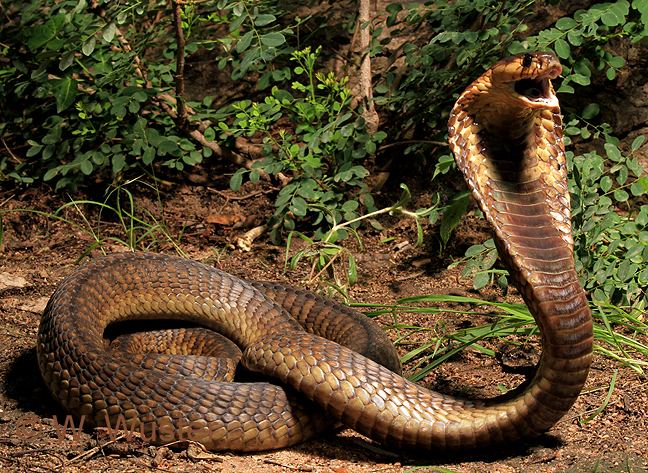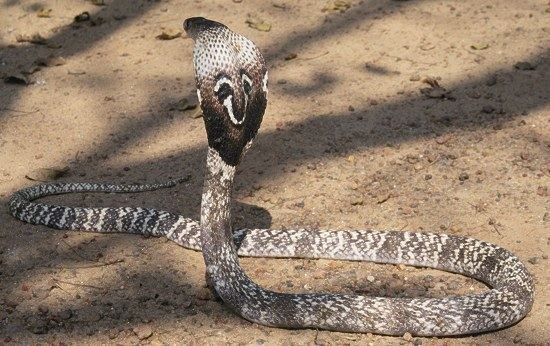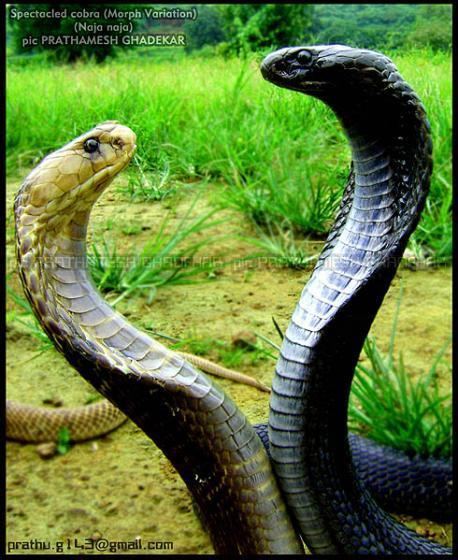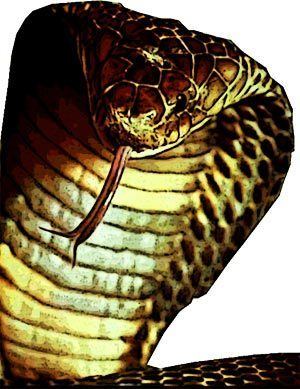Suborder Serpentes Scientific name Naja Phylum Chordata | Higher classification Elapidae Rank Genus | |
 | ||
Lower classifications | ||
Naja is a genus of venomous elapid snakes known as cobras. Several other genera include species commonly called cobras (for example the ring-necked spitting cobra and the king cobra), but members of the genus Naja are the most widespread and the most widely recognized as "true" cobras. Various species occur in regions throughout Africa, Southwest Asia, South Asia, and Southeast Asia.
Contents
- Indian spectacled cobra aks naja snake rescue venomous
- Etymology
- Description
- Venom
- Taxonomy
- Species
- References

Until recently, the genus Naja had 20 to 22 species, but it has undergone several taxonomic revisions in recent years, so sources vary greatly. Wide support exists, though, for a 2009 revision that synonymised the genera Boulengerina and Paranaja with Naja. According to that revision, the genus Naja now includes 28 species.

Indian spectacled cobra aks naja snake rescue venomous
Etymology

The origin of this genus name is from the Sanskrit nāga (with a hard "g") meaning "snake". Some hold that the Sanskrit word is cognate with English "snake", Germanic: *snēk-a-, Proto-IE: *(s)nēg-o-, but this is unlikely. Mayrhofer calls this etymology "unglaubhaft ", "not credible", and suggests a more plausible etymology connecting it with Sanskrit nagna, "hairless, naked".
Description

Naja species vary in length and most are relatively slender-bodied snakes. Most species are capable of attaining lengths of 1.84 m (6.0 ft). Maximum lengths for some of the larger species of cobras are around 3.1 m (10 ft), with the forest cobra arguably being the longest species. All have a characteristic ability to raise the front quarters of their bodies off the ground and flatten their necks to appear larger to a potential predator.
Venom
All species in the genus Naja are capable of delivering a fatal bite to a human. Most species have strongly neurotoxic venom, which attacks the nervous system, causing paralysis, but many also have cytotoxic features which cause swelling and necrosis, and have a significant anticoagulant effect. Some also have cardiotoxic components to their venoms.
Several Naja species, referred to as spitting cobras, have a specialized venom delivery mechanism, in which their front fangs, instead of releasing venom through the tips (similar to a hypodermic needle), have a rifled opening in the front surface which allows the snake to propel the venom out of the mouth. While typically referred to as "spitting", the action is more like squirting. The range and accuracy with which they can shoot their venom varies from species to species, but it is used primarily as a defense mechanism. Once sprayed onto a victim's skin, the venom acts as a severe irritant. If it is introduced to the eye, it can cause a severe burning sensation and temporary or even permanent blindness if not cleaned out immediately and thoroughly.
Contrary to popular belief, the Philippine cobra (N. philippinensis) is not the most venomous Naja species. The Caspian cobra (N. oxiana) of Central Asia produces a more toxic venom. The average subcutaneous LD50 for N. oxiana in mice is 0.18 mg/kg, and the lowest reported value for N. oxiana is 0.10 mg/kg subcutis. while N. philippinensis has an average murine LD50 of 0.2 mg/kg subcutis. The lowest value reported for N. philippinensis is 0.14 mg/kg subcutis. In mice, the intravenous LD50 for the Caspian cobra is 0.037 mg/kg, and for the Philippine cobra it is 0.05 mg/kg. The Caspian cobra is the most venomous species of cobras in the world (to laboratory mice). The crude venom of N. oxiana produced the lowest known lethal dose (LCLo) of 0.005 mg/kg, the lowest among all cobra species ever recorded, derived from an individual case of poisoning by intracerebroventricular injection. After the Caspian and Philippine cobras, the forest cobra (N. melanoleuca) has an LD50 of 0.225 mg/kg subcutis, followed by the Samar cobra (N. samarensis) which has a value of 0.23 mg/kg subcutis. The water cobras of central Africa are also highly venomous. The murine intraperitoneal LD50 of Naja annulata and Naja christyi venoms were 0.143 mg/kg and 0.120 mg/kg, respectively.
The Naja species are a medically important group of snakes due to the number of bites and fatalities they cause across their geographical range. They range throughout Africa (including some parts of the Sahara where Naja haje can be found), Southwest Asia, Central Asia, South Asia, East Asia, and Southeast Asia. Roughly 30–40% of bites by some cobra species are dry bites, thus do not cause envenomation (a dry bite is a bite by venomous snake which does not inject venom).
Many factors influence the differences in cases of fatality among different species within the same genus. Among cobras, the cases of fatal outcome of bites in both treated and untreated victims can be quite large. For example, mortality rates among untreated cases of envenomation by the cobras as a whole group ranges from 6.5–10% for N kaouthia. to about 70% for N. oxiana. Mortality rate for Naja atra is between 15 and 20%, 5–10% for N. nigricollis, 50% for N. nivea, 65–70% for N. melanoleuca, 20–25% for N. naja, and 50–60% for N. samarensis. In cases where victims of cobra bites are medically treated using normal treatment protocol for elapid type envenomation, differences in prognosis depend on the cobra species involved. The vast majority of envenomated patients treated make quick and complete recoveries, while other envenomated patients who receive similar treatment result in fatalities. The most important factors in the difference of mortality rates among victims envenomated by cobras is the severity of the bite and which cobra species caused the envenomation. The Caspian cobra (N. oxiana) and the Philippine cobra (N. philippinensis) are the two cobra species with the most toxic venoms based on LD50 studies on mice. Both species cause prominent neurotoxicity and progression of life-threatening symptoms following envenomation. Death has been reported in as little as 30 minutes in cases of envenomation by both species. N. philippinensis's purely neurotoxic venom causes prominent neurotoxicity with minimal local tissue damage and pain and patients respond very well to antivenom therapy if treatment is administered rapidly after envenomation. Envenomation caused by N. oxiana is much more complicated. In addition to prominent neurotoxicity, very potent cytotoxic and cardiotoxic components are in this species' venom. Local effects are marked and manifest in all cases of envenomation - severe pain, severe swelling, bruising, blistering, and tissue necrosis. Renal damage and cardiotoxicity are also clinical manifestations of envenomation caused by N. oxiana, though they are rare and secondary. The untreated mortality rate among those envenomed by N. oxiana approaches 80%, the highest among all species within the genus Naja. Antivenom is not as effective for envenomation by this species as it is for other Asiatic cobras within the same region, like the Indian cobra (N. naja) and due to the dangerous toxicity of this species' venom, massive amounts of antivenom are often required for patients. As a result, a monovalent antivenom serum is being developed by the Razi Vaccine and Serum Research Institute in Iran. Response to treatment with antivenom is generally poor among patients, so mechanical ventilation and endotracheal intubation is required. As a result, mortality among those treated for N. oxiana envenomation is still relatively high (up to 30%) compared to all other species of cobra (<1%).
Taxonomy
The genus contains several species complexes of closely related and often similar species, some of them only recently described or defined. Several recent taxonomic studies have revealed species not included in the current listing in ITIS:
Two recent molecular phylogenetic studies have also supported the incorporation of the species normally assigned to the genera Boulengerina and Paranaja into Naja, as both are closely related to the forest cobra (Naja melanoleuca).
Wallach et al. suggested recognition of four subgenera within Naja: Naja for the Asiatic cobras, Boulengerina for the African forest, water and burrowing cobras, Uraeus for the Egyptian and Cape cobra group and Afronaja for the African spitting cobras.
Species
* Not including the nominate subspecies.
† Extinct.
T Type species.
